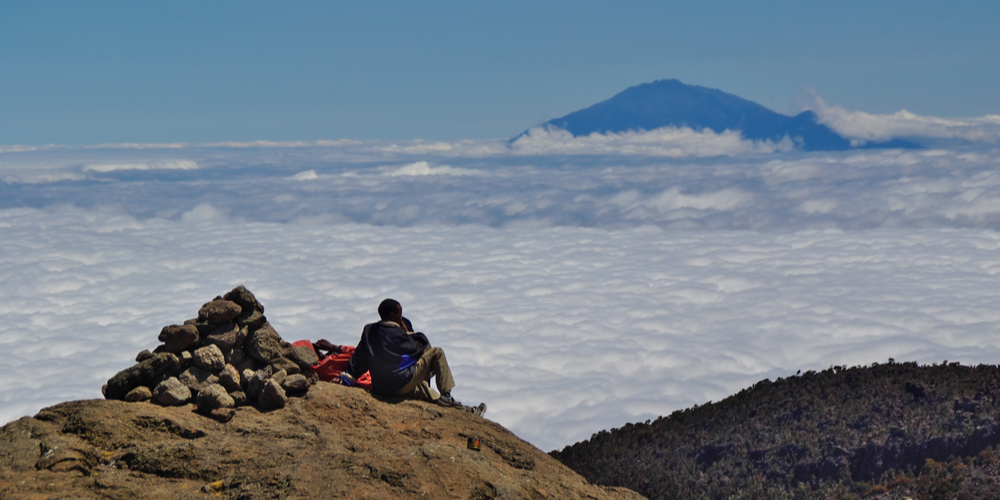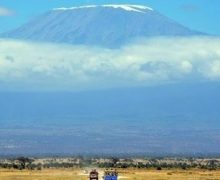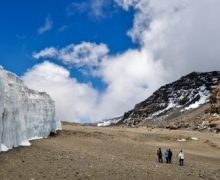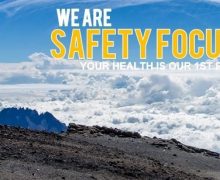The percentage of oxygen in the atmosphere at sea level is about 21%. As altitude increases, the percentage remains the same but the number of oxygen molecules per breath is reduced. At 12,000 feet (3,600 m) there are roughly 40% fewer oxygen molecules per breath so the body must adjust to having less oxygen. Altitude sickness, known as AMS, is caused by the failure of the body to adapt quickly enough to the reduced oxygen at increased altitudes. Altitude sickness can occur in some people as low as 8,000 feet, but serious symptoms do not usually occur until over 12,000 feet.
Mountain medicine recognizes three altitude categories:
- High altitude: 4,900 to 11,500 ft (1,500 to 3,500 m)
- Very high altitude: 11,500 to 18,000 ft (3,500 to 5,500 m)
- Extreme altitude: 18,000 ft and above (5,500 m and above)
In the first category, high altitude, AMS and decreased performance is common. In the second category, very high altitude, AMS and decreased performance are expected. And in extreme altitude, humans can function only for short periods of time, with acclimatization. Mount Kilimanjaro's summit stands at 19,340 feet - in extreme altitude.
At over 10,000 feet (3,000 m), more than 75% of climbers will experience at least some form of mild AMS.
There are four factors related to AMS:
- High Altitude
- Fast Rate of Ascent
- High Degree of Extertion
- Dehydration
The main cause of altitude sickness is going too high (altitude) too quickly (rate of ascent). Given enough time, your body will adapt to the decrease in oxygen at a specific altitude. This process is known as acclimatization and generally takes one to three days at any given altitude. Several changes take place in the body which enable it to cope with decreased oxygen:
- The depth of respiration increases
- The body produces more red blood cells to carry oxygen
- Pressure in pulmonary capillaries is increased, "forcing" blood into parts of the lung which are not normally used when breathing at sea level
- The body produces more of a particular enzyme that causes the release of oxygen from hemoglobin to the body tissues
Again, AMS is very common at high altitude. It is difficult to determine who may be affected by altitude sickness since there are no specific factors such as age, sex, or physical condition that correlate with susceptibility. Many people will experience mild AMS during the acclimatization process. The symptoms usually start 12 to 24 hours after arrival at altitude and will normally disappear within 48 hours. The symptoms of Mild AMS include:
- Headache
- Nausea & Dizziness
- Loss of appetite
- Fatigue
- Shortness of breath
- Disturbed sleep
- General feeling of malaise
Symptoms tend to be worse at night and when respiratory drive is decreased. Mild AMS does not interfere with normal activity and symptoms generally subside as the body acclimatizes. As long as symptoms are mild, and only a nuisance, ascent can continue at a moderate rate.
While hiking, it is essential that you communicate any symptoms of illness immediately to others on your trip.
The signs and symptoms of Moderate AMS include:
- Severe headache that is not relieved by medication
- Nausea and vomiting, increasing weakness and fatigue
- Shortness of breath
- Decreased coordination (ataxia)
Normal activity is difficult, although the person may still be able to walk on their own. At this stage, only advanced medications or descent can reverse the problem. It is important to get the person to descend before the ataxia reaches the point where they cannot walk on their own (which would necessitate a stretcher evacuation). Descending only 1,000 feet (300 m) will result in some improvement, and 24 hours at the lower altitude will result in a significant improvement.
Continuing on to higher altitude while experiencing moderate AMS can lead to death.
Severe AMS results in an increase in the severity of the aforementioned symptoms including:
- Shortness of breath at rest
- Inability to walk
- Decreasing mental status
- Fluid build-up in the lungs
Severe AMS requires immediate descent of around 2,000 feet (600 m) to a lower altitude. There are two serious conditions associated with severe altitude sickness; High Altitude Cerebral Edema (HACE) and High Altitude Pulmonary Edema (HAPE). Both of these happen less frequently, especially to those who are properly acclimatized. But, when they do occur, it is usually in people going too high too fast or going very high and staying there. In both cases the lack of oxygen results in leakage of fluid through the capillary walls into either the lungs or the brain.
High Altitude Pulmonary Edema (HAPE)
HAPE results from fluid build up in the lungs. This fluid prevents effective oxygen exchange. As the condition becomes more severe, the level of oxygen in the bloodstream decreases, which leads to cyanosis, impaired cerebral function, and death. Symptoms of HAPE include:
- Shortness of breath at rest
- Tightness in the chest
- Persistent cough bringing up white, watery, or frothy fluid
- Marked fatigue and weakness
- A feeling of impending suffocation at night
- Confusion, and irrational behavior
Confusion, and irrational behavior are signs that insufficient oxygen is reaching the brain. In cases of HAPE, immediate descent of around 2,000 feet (600 m) is a necessary life-saving measure. Anyone suffering from HAPE must be evacuated to a medical facility for proper follow-up treatment.
High Altitude Cerebral Edema (HACE)
HACE is the result of the swelling of brain tissue from fluid leakage. Symptoms of HACE include:
- Headache
- Weakness
- Disorientation
- Loss of co-ordination
- Decreasing levels of consciousness
- Loss of memory
- Hallucinations & Psychotic behavior
- Coma
This condition is rapidly fatal unless the afflicted person experiences immediate descent. Anyone suffering from HACE must be evacuated to a medical facility for follow-up treatment.









